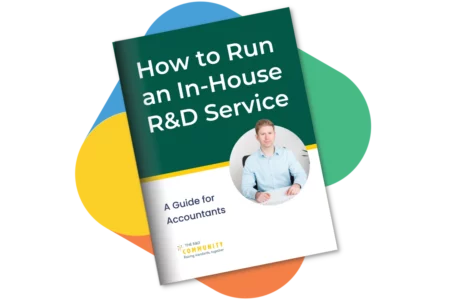Assessing your readiness
While the prospect of a share of the fabled unclaimed billions might entice some in search of potential financial rewards, the reality is that this is now an industry under intense scrutiny which deals with some of the most complex areas of taxation. Consequently, I strongly advise against venturing into this domain blindly unless you have some prior exposure to the R&D tax scheme or a background in science and technology.
For those entirely new to this, I recommend gaining some relevant industry experience first before considering you embark on your own. This foundational phase of practical learning and growth sets the stage for a more confident and successful transition into independent practice. Once you have that experience, you can start to think about an independent venture and all that’s involved with this.
Crafting Your Path
Becoming an R&D tax adviser offers an exciting chance to be a driving force behind innovation and progress. However, this journey also demands a comprehensive understanding of the relevant R&D tax legislation and supporting guidance. Acquiring this knowledge takes time and effort. Before you can offer any advice to others, you need to ensure your knowledge is as good as it can be. This requires personal commitment, and this investment is not to be underestimated. If you want to be a successful R&D tax adviser, I would recommend that you:
- Become familiar with the contents of CIRD80000 onwards,
- Have a good awareness of how the CIRD guidance links with the Corporation Tax Act 2009,
- Fully acquaint yourself with the contents of HMRC’s Collection: Research and Development (R&D) tax relief pages, which include the latest guidance on topics like the additional information form,
- Understand the practicalities of applying the R&D tax scheme rules to SMEs and large companies and all of the potential nuances that this involves.
And that’s just for starters! A commitment to CPD is vital to keep your knowledge up-to-date and relevant as the scheme evolves. Luckily, these days, you don’t have to embark on this journey alone. There are specialist R&D training providers and networks like The R&D Community. The ATT, CIOT and ACCA (amongst others) also include elements of R&D tax learning within their qualifications. Joining a training provider like one of these is an important investment on the journey to becoming a successful R&D tax adviser.
What’s in a name?
The age-old question: What’s in a name? You’ll have noticed that some choose to use the term consultant, while others use adviser or advisor. Practically, it all boils down to the same thing. While advisor is more often used by our US colleagues, it’s still a perfectly acceptable spelling in the UK. HMRC tends to sway towards using the phrase R&D tax adviser, which is my personal preference. Really, it’s a bit like choosing between tea and coffee – we all have our preferences, and there are no right or wrong answers. Professionalism, credibility, and nailing your craft are more important.
Starting out in the right direction
Starting out in business involves many considerations. Let’s assume that you’ve already chosen your preferred business structure, typically a limited company, and completed company registration (we won’t be covering those aspects here). You’ve also now got the required knowledge to help others. What’s next? Are there any special rules or regulations you need to follow? Is there any specific guidance?
Just as the term ‘accountant’ is not regulated in the UK, allowing anyone to use it regardless of qualifications, a similar scenario applies to ‘tax adviser,’ or ‘tax consultant’. This means individuals can use these titles regardless of their background, experience, or training. However, an ethical code of professional standards does exist for those operating in the R&D tax industry.
Published jointly by seven of the UK’s professional bodies in June 2020, this guidance bears the long-winded title of ‘Topical Guidance covering the application of professional standards to the provision of R&D tax credit services’. While it is aimed at professional body members, anyone who aspires to work in this field should hold themselves accountable to these standards. If you want to be a responsible and trusted adviser, this guidance should be your bible for the standards expected from you. Amongst lots of other useful information, this guidance explains that:
- Only competent members should provide R&D tax advice, and knowledge must be maintained at the required levels. As a result, CPD must be maintained to ensure competence in R&D claims,
- Websites must accurately represent services, avoiding misleading claims (like a “100% of claims agreed”),
- Advisers should address HMRC queries professionally and courteously,
- All members, including R&D advisers, must comply with AML laws and rules. As a result, AML supervision is required for firms giving R&D tax advice.
Although voluntary for non-professional body members, you should also be seeking to act and operate in accordance with the broader principles of the ‘Professional Conduct in Relation to Taxation’.
Anti-Money Laundering (AML) supervision
Now things start to get serious! Your next practical step, before providing any advice or attempting to set up an agent account with HMRC, is likely to be AML registration.
Any doubt about whether R&D tax advisers must be appropriately AML registered and supervised should have been dispelled when the previously-mentioned guidance was published in 2020. This states:
Advice on R&D tax credit claims is considered by the PCRT Bodies as the provision of advice in the area of taxation and therefore subject to AML supervision.
HMRC can and do penalise businesses that are not AML registered before they start trading. It’s not unheard of for late registration penalties to be in the region of £52,000, and businesses incurring a penalty are publicly named and shamed. Professional body members should register with their appropriate professional body. Unaffiliated advisers should register with HMRC.
AML responsibilities don’t stop with registration. There are requirements for business and client risk assessment, Customer Due Diligence, and Know Your Customer (KYC) protocols, as well as ongoing staff AML training.
HMRC Agent Account(s)
Once you are AML registered, you can apply for an HMRC agent account. You are an ‘agent’ in the eyes of HMRC if you do work for clients.
An agent account is separate from your own HMRC business account, which you’ll use to file your own business tax return. The agent account serves the purpose of allowing you to file claims on behalf of your clients. It also provides you with a unique agent reference, which is needed for certain types of HMRC client authorisation. You can apply for an agent account via your business gateway account. HMRC currently have two types of agent account:
- HMRC online services account for agents – the traditional HMRC agent account that’s been around for years.
- Agent Services Account – a newer type of agent account, needed for submitting the Additional Information Form for multiple clients.
It is a good idea to register for both accounts as soon as possible. You’ll need to have the first type of account before you can apply for the second if you are making an online application. It’s currently taking HMRC around 4-8 weeks to authorise agents for the first account. For detailed instructions on setting up your HMRC online Services account, refer to this HMRC guidance. You should be applying for Corporation Tax access (for R&D claims).
Business website
A good website can help boost an R&D tax adviser’s credibility, help with client acquisition, showcase your expertise, and provide 24/7 accessible information for clients to find out about your services. I won’t be giving a 101 on website production in this article – I’ll assume that’s already been done.
However, on any website, you should ensure your R&D marketing claims are truthful and accurate and don’t use any disingenuous claims like having a “100% success rate” or claiming to be somehow HMRC approved. The guidance mentioned above has some recommendations about what R&D advisers should and should not say on their websites.
GDPR regulations
An R&D tax adviser with a website will need to register with the Information Commissioner’s Office (ICO) for GDPR purposes to ensure compliance with data protection regulations. Your website will likely collect personal data from clients, even if that is just cookies.
Registering with the ICO demonstrates a commitment to protecting clients’ sensitive data and enables individuals to exercise their rights regarding their personal information. This proactive step not only fosters trust between your business and its clients but also helps avoid potential legal penalties for non-compliance with GDPR regulations. The ICO website has more information about data protection registration.
Insurances
Professional Indemnity Insurance (PII) is crucial for an R&D tax adviser to provide comprehensive protection for both themselves and potential clients. R&D tax advisers offer specialised services which involve complex areas of taxation that leave room for potential errors or omissions. PII safeguards against financial losses arising from any professional mistakes, negligence, or inaccurate advice that might unintentionally occur.
For R&D tax advisers, PII provides a potential safety net for any unforeseen issues. More importantly, PII offers protection to clients seeking advice from a tax professional. Not all tax advisers or R&D consultants hold this insurance. HMRC estimates that 58% of unaffiliated tax agents and 30% of affiliated tax agents don’t hold PII, underscoring the value this can add to your business by highlighting you as a responsible adviser.
Continuing Professional Development (CPD)
An R&D tax adviser should maintain a commitment to continuing professional development (CPD) and stay updated with the latest knowledge, regulations, and changes made to the R&D tax relief scheme. Staying current is essential for providing accurate, effective, and compliant advice to clients.
Additionally, a commitment to CPD enhances the adviser’s professional credibility and expertise, reinforcing trust with clients who rely on their guidance for strategic decision-making. By consistently expanding your knowledge base, you can adapt to new challenges and opportunities, ultimately delivering higher-quality services and maintaining a competitive edge in the industry.
Determine your offering
Having a Unique Selling Proposition (USP) is always invaluable. What exactly will you do, and how will your services differ from any other R&D provider? What sets you apart? Devote time to refine your offerings. Will you submit company tax returns? If so, you’ll need submission software. Will you be responsible for completing the Additional Information form? Do you have the necessary skills to help support clients with HMRC enquiries or will you partner with a specialist for this? Do you want a software partner to help with R&D claims completion? This is your unique journey, and you’re beginning with a blank canvas, so paint the masterpiece that brings you the most enjoyment and fulfilment!
Software requirements
Depending on the specific services you offer, your software needs might vary. For example, you might need software solutions for tax return filing or want to explore R&D claims automation or preparation software. This R&D Community article has guidance to help you determine the most suitable options for your needs.
RDCF and HMRC updates
Now that you’re becoming established as an R&D adviser, you’ll want to get yourself on the relevant mailing lists to stay updated on developments. This might include getting on the mailing list for the RDCF or signing up for alerts on key relevant publications, like HMRC’s regular Agent Updates.
Marketing and Client Acquisition
Following these steps will have you well prepared for starting your R&D tax relief service, but now you need clients. This can be a daunting prospect as most advisers lack the advantage of having an established reputation and client referrals, and it can be difficult to compete against more established firms. Don’t worry, there is still plenty of room left for you, and careful consideration of your online presence and marketing strategy can yield dividends in building your client base.
If you are looking for some further advice, especially if you are thinking about adding an R&D service to an already established business, there is some useful information in the downloadable resource “How to run an in-house R&D service”. It also includes a 2-page service planning worksheet which helps you to document your decisions and share them





